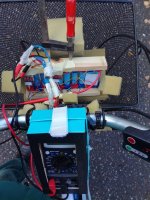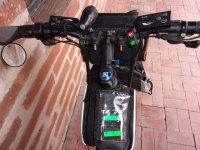Low voltage alarm for many LiPo cells?
Summary:
Is there a simple and cheap way to to get a visual or audible alarm, if ANY LiPo cell voltage goes under a set voltage in my electric bike during riding? (without a bms during discharge).
Something like several buzzer alarms https://www.banggood.com/buy/lipo-tester.html, about 1 USD for 8 cells in quantity of 20x, but more practical.
Long story:
My bicycle has a 250 W hub motor, a 15 Ampere "no name" controller 36 V, and a Chinese bottle battery of about 320 Watt hour capacity (8 Ampere hours). Inside the bottle there is a BMS and 40 pcs of 18650 cells "no name". A charger for LiPo batteries max 42 V (4.2V/cell), which came with the bottle battery, 2 A charge current. All these were once bought together as a kit.
I have also 6 pcs of 5 Ampere hour 18 Volt LiPo packs (Zippy Flightmax 5000 Ah 5s) discharging max 20C, or 100 Amperes. There is balancing charger Imax B6ac up to 6 serial.
During 2-4 years I have happily used both batteries SEPARATELY(either the bottle battery or all the Zippy packs in configuration 10s3p). Suddenly the bottle battery refused to take charge.
Assuming the bottle battery is now scrap, I opened it to learn about batteries, cut all the wires and cut the point welded nickel(?) connections. Most 18650 cells had 4.1 V charge , 12 cells had about 4 v. Apparently none of them was dead. But the bottle battery cannot be assembled as it was. I tested one 18650 cell capacity by discharging from 4.2V to 3V and then charging. 1996 mAh.
An idea: what if I use Vruzend plastic connectors for the 40 pcs of 18650 cells and assemble them in packs of 5s, 8 packs total? (each pack like one Zippy pack 5s). Then with thick cables (as Zippy has) I could combine 2 packs to 10s. Those pairs can be temporarily parallelled with thick wires up to 4p at ground and 36V level(nominal) to get e.g a configuration 4p10s. No bms, but always balance charging with Imax B6ac to 4.2V/cell. The original cell might have had capacity 2.2 Ah as new, and max burst discharge 2C = 4.4 A .
During riding/discharging there has been no balancing of Zippy cells, no balancing wires used. Paralleling connections are only at ground and 36V level(nominal). I have tried to be careful not to discharge under 3.6 volt in any cell. Stopping the ride when in doubt and checking with a Hobby King cell checker
https://hobbyking.com/en_us/6s-hobbyking-lipo-cell-checker.html?___store=en_us
Balancing only when charging. Zippy zells still keep their balance well.
The Lipo cell checkers from Banggood (https://www.banggood.com/buy/lipo-tester.html) would be a feasible solution, only 15 cents per cell, but I have to insert/remove the display/buzzer products before and after each ride to prevent discharging when not in use. Too awkward, if there are e.g. 14 insertions each time. The accuracy is not very good, but that is not so important. But anyhow, this example shows that there might be solutions to this problem at a very low cost. An Arduino based simple circuit to read the voltages from each cell? I have made simple Arduino boards for my own use, but how to simply read/multiplex/scale 42 Volts to an 5 Volt AD-converter. (how has the product from banggodd done it?).
If there is an easy to understand way to read and hear the offending voltages during riding (without stopping) I could later replace or remove the worst cells, and also expand the battery with used 18650 cells from Ebay. I would like to use both Zippy packs and self made packs of 18650 cells parallelly connected together.
Ideas?
Summary:
Is there a simple and cheap way to to get a visual or audible alarm, if ANY LiPo cell voltage goes under a set voltage in my electric bike during riding? (without a bms during discharge).
Something like several buzzer alarms https://www.banggood.com/buy/lipo-tester.html, about 1 USD for 8 cells in quantity of 20x, but more practical.
Long story:
My bicycle has a 250 W hub motor, a 15 Ampere "no name" controller 36 V, and a Chinese bottle battery of about 320 Watt hour capacity (8 Ampere hours). Inside the bottle there is a BMS and 40 pcs of 18650 cells "no name". A charger for LiPo batteries max 42 V (4.2V/cell), which came with the bottle battery, 2 A charge current. All these were once bought together as a kit.
I have also 6 pcs of 5 Ampere hour 18 Volt LiPo packs (Zippy Flightmax 5000 Ah 5s) discharging max 20C, or 100 Amperes. There is balancing charger Imax B6ac up to 6 serial.
During 2-4 years I have happily used both batteries SEPARATELY(either the bottle battery or all the Zippy packs in configuration 10s3p). Suddenly the bottle battery refused to take charge.
Assuming the bottle battery is now scrap, I opened it to learn about batteries, cut all the wires and cut the point welded nickel(?) connections. Most 18650 cells had 4.1 V charge , 12 cells had about 4 v. Apparently none of them was dead. But the bottle battery cannot be assembled as it was. I tested one 18650 cell capacity by discharging from 4.2V to 3V and then charging. 1996 mAh.
An idea: what if I use Vruzend plastic connectors for the 40 pcs of 18650 cells and assemble them in packs of 5s, 8 packs total? (each pack like one Zippy pack 5s). Then with thick cables (as Zippy has) I could combine 2 packs to 10s. Those pairs can be temporarily parallelled with thick wires up to 4p at ground and 36V level(nominal) to get e.g a configuration 4p10s. No bms, but always balance charging with Imax B6ac to 4.2V/cell. The original cell might have had capacity 2.2 Ah as new, and max burst discharge 2C = 4.4 A .
During riding/discharging there has been no balancing of Zippy cells, no balancing wires used. Paralleling connections are only at ground and 36V level(nominal). I have tried to be careful not to discharge under 3.6 volt in any cell. Stopping the ride when in doubt and checking with a Hobby King cell checker
https://hobbyking.com/en_us/6s-hobbyking-lipo-cell-checker.html?___store=en_us
Balancing only when charging. Zippy zells still keep their balance well.
The Lipo cell checkers from Banggood (https://www.banggood.com/buy/lipo-tester.html) would be a feasible solution, only 15 cents per cell, but I have to insert/remove the display/buzzer products before and after each ride to prevent discharging when not in use. Too awkward, if there are e.g. 14 insertions each time. The accuracy is not very good, but that is not so important. But anyhow, this example shows that there might be solutions to this problem at a very low cost. An Arduino based simple circuit to read the voltages from each cell? I have made simple Arduino boards for my own use, but how to simply read/multiplex/scale 42 Volts to an 5 Volt AD-converter. (how has the product from banggodd done it?).
If there is an easy to understand way to read and hear the offending voltages during riding (without stopping) I could later replace or remove the worst cells, and also expand the battery with used 18650 cells from Ebay. I would like to use both Zippy packs and self made packs of 18650 cells parallelly connected together.
Ideas?




